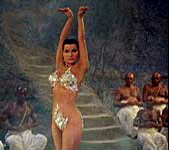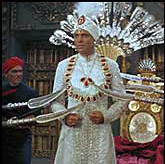| |||||||||||||||||||||||||||||||||||||||

|
| ||||||||||||||||||||||||||||||||||||||
|
|
|
The Tiger of Eschnapur first strikes one as being breathtakingly exotic, and then remarkably juvenile. Dashing hero Harald Berger bops two troublesome Gurkha soldiers together like sticks of wood, and charms the beautiful Seetha with schoolboy manners and other pure-of-heart gestures. The action is hearty and direct. There are beautiful scenes shot in India with real tigers, matched with wonderfully naive shots of men in tiger costumes! A relaxed tempo allows the story to unfold at a leisurely pace and keeps our interest with how it is told rather than piling up incident on incident. This is probably going to be the toughest obstacle for standard, impatient audiences. The tone is somewhere between The Thief of Bagdad and The Wind and the Lion, minus massive battle scenes. There's nothing outright fantastical about the movie, but every scene has the feel of its exotic, alien locations. In 1959 there were still places on the globe where absolute rulers still existed, and maybe there still are. 
The acting is direct and uncomplicated. Top-billed Debra Paget is excellent here as she rarely was in American films. Her Seetha is torn between two separate heritages - she has a forgotten Irish Father named Joe. She also does a terrific exotic dance before an enormous female idol, in which she straddles a giant blue hand and writhes about in total abandon. It's the highlight of the show. 1 Seetha and Berger fall in love singing a song she remembers from childhood, which he recognizes as an Irish tune. Strangely enough, the film's main theme starts with a melody line reminiscent of the 'Chuckaluck' song from Rancho Notorious - did Fritz Lang dictate the melody himself? As the architect, Paul Hubschmid is an impressive hero and would have looked a good James Bond, if his accent had been the correct one. If he looks familiar, six years earlier he was the hero of The Beast from 20,000 Fathoms! as Paul Christian. 2 Most of the main players are Germans as well, and all do great work. Walter Reyer's Chandra has the right air of aggressive aristocracy, and the other 'Indian' actors are so convincing, that it's a shock to see them show up with German surnames. Down in the cast list, you'll find Italiana Luciana Paluzzi, who later thrilled us all as one of the best of the James Bond bad women in Thunderball. It's also amusing to hear this entire epic enacted in German, with all of the Indian characters talking about grabmals (tombs), spinnen (spiders) and blumen (flowers). It reminds us that in our movies, we have no problem accepting everyone in the world speaking perfect English. Where this show really kicks in, is of course the directing contribution of Fritz Lang. This is a designed movie, stem to stern. There are huge sets of fascinating complexity, beautifully lit. They're purposefully rather empty, and remind us of Lang's later American career, where from The Big Heat on, his pictures became exercises in minimalism. His last US film, Beyond a Reasonable Doubt, practically took place in bare-walled generic sets. He seemed to be seeking a pure cinematic space - the tensions between his characters and his camera were everything - and the bric-a-brac was an unnecessary distraction. Here in the Indian films, the sets are very detailed, yet clean and uncluttered. This illusion is amplified by the fact that both films are presented full frame 1:37. As can be seen by the horizontal rectangle formed by the main titles, they were originally matted to a widescreen aspect ratio, with a piece of the top of the frame, and a much larger slice off the bottom, meant to be masked away. Thus, the sets and the compositions look 'looser' than they should. Almost like John Ford, Lang plays his action wide, and even in the tense scenes in the catacombs stays far away from his actors. The camera moves, but not much; the feeling imparted is that Lang purposely wanted this adventure to be old-fashioned and the film to play as a series of tableaux something like a silent movie. It's a lot like Georges Franju's marvelous Judex, a serious but nostalgic adventure imbued with a sense of wonder.
|
|
The Tiger of Eschnapur ended with a wonderful cliffhanger and exciting titles exhorting the audience to come back for more thrills. The Indian Tomb continues the saga by upping the stakes, bringing the tensions to a boil, and introducing two more characters. Harald Berger's charming sister, Irene, tries to fathom the inscrutable hatred of Chandra, while single-handedly working through the mystery of her missing brother and the imprisoned temple dancer. Along the way is another knockout exotic dance (with Ms. Paget in an even more revealing costume), an encounter with the horde of lepers locked away in the catacombs, and a full-scale palace revolt. Just as in Lang's ancient Die Niebelungen, the nominal hero is out of action for the better part of this second installment, becoming just another victim of a complex series of intrigues and deceptions. Chandra's hatred is inflamed by Ramigani's lies, in hopes of leading him into a trap. Seetha's cooperation is coerced by a combination of promises and threats. Even the new German captives know that Seetha is scheduled for murder on her wedding night, so they're packing the foundation of the palace with explosives! 
What impresses most about these films is the set pieces and the details, the whole fabric of design and construction. There's an episode where a spider's web saves the lives of the hero and heroine. Seetha uses their only provisions as a gift for her god, and tries to force Harald into accepting that the spider was sent to save them as an answer. The philosophy of the film seems to be that only experience can bring wisdom, and that there's a fate in store for us commensurate with our virtues. A bunch of baddies come to violent ends, but the foolish Chandra proves himself a basically good man by taking penance for his crimes. It's a lightweight story, yet one with an integrity of its own. As with the rest of Lang's work, power and sex inspire no end of misadventure. Incidentally, the real Indian location has a riverside Palace that looks an awful lot like the location used in Octopussy, many years later. Perhaps there are a lot of places like that - ? 3 Fantoma's DVDs of The Tiger of Eschnapur and The Indian Tomb are a handsome treat indeed. The transfers are very clean and blemish-free, with striking colors. Grain is apparent in some scenes, mostly opticals (and one curious shot in Seetha's temple dance in Tiger) and is easily overlooked. 16:9 enhancement would have made the transfers perfect, but Savant isn't complaining. Tom Gunning provides some nice insert notes. Each disc has a good still section as well. With resourceful and dedicated companies around like Fantoma, what treasures will be next? How about that other never-shown two-part adventure film from around the same time, Mistress of the World? Like these pictures, it was directed by a German returning to his native country (William Dieterle) and has a bizarre international cast that includes Martha Hyer and Sabu. And it deals with a chase around the world to secure a mysterious invention, as in Until the End of the World! The Tiger of Eschnapur and The Indian Tomb may not be your idea of must-purchase discs, but if you like the truly exotic in movies Savant suggests you give them a chance. And don't forget the torpedo thighs!
On a scale of Excellent, Good, Fair, and Poor,
Footnotes:
1. This scene also got a rise out of English critic Raymond Durgnat, who
lustfully described Debra Paget's 'torpedo thighs'. Yep, quite an exhibition and a reminder that
these films aren't as juvenile as first thought!
2. for Journey to the Lost City, Hubschmid was again billed as Paul
Christian!
3. Note from reader Christian Raupach:
|
|
| ||||||||||||||||||||||||||||||||
Copyright 2007 DVDTalk.com All Rights Reserved. | |||||||||||||||||||||||||||||||||||||||




